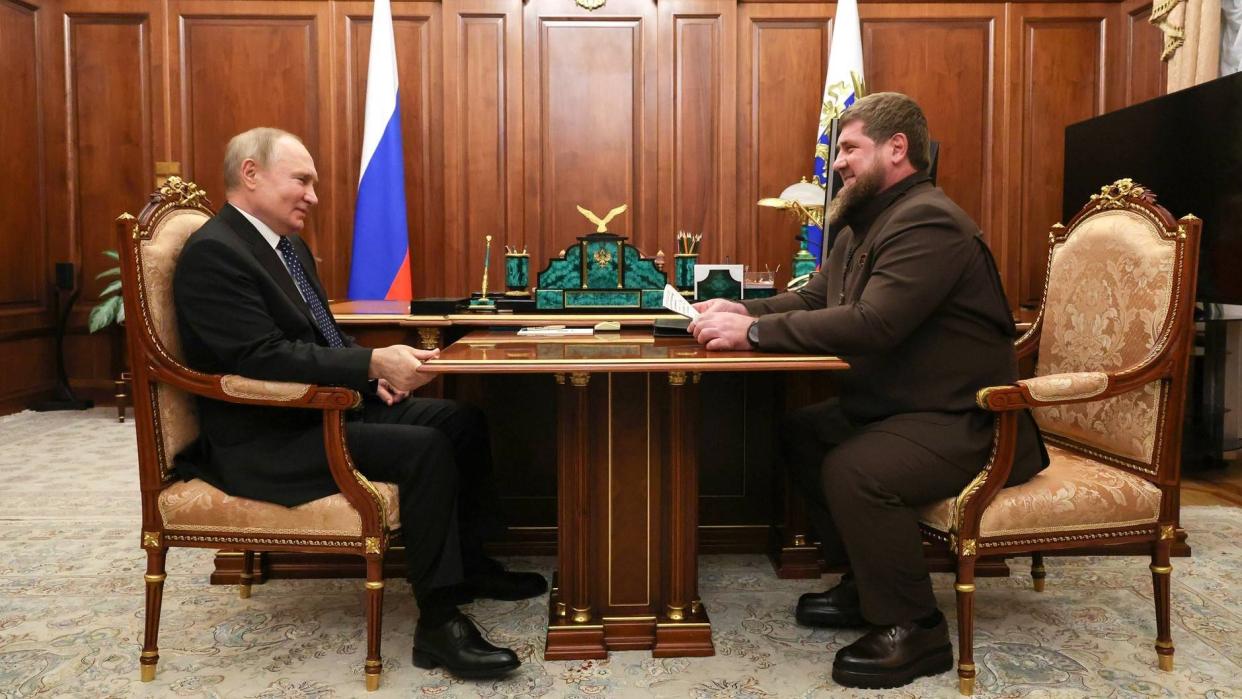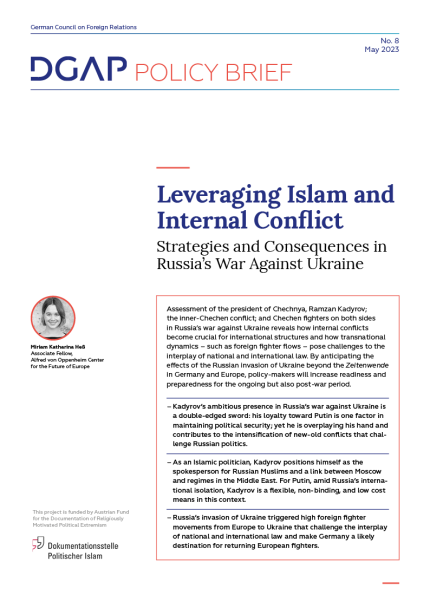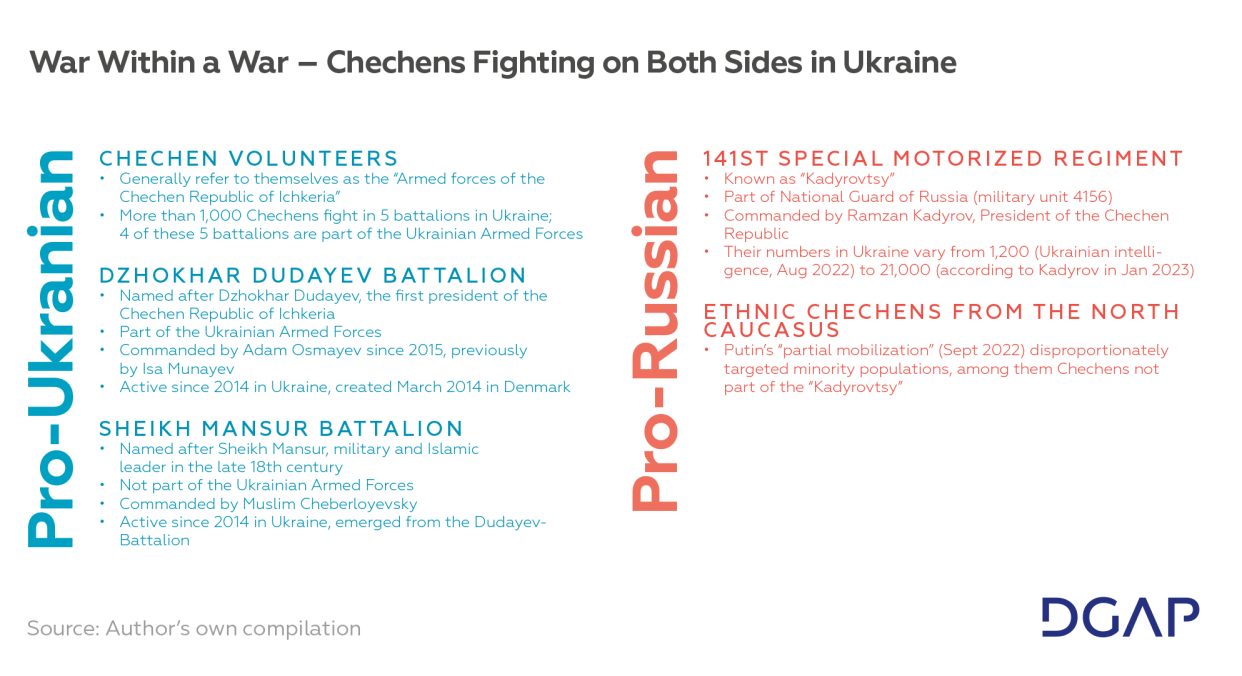Miriam Katharina Heß

Assessment of the president of Chechnya, Ramzan Kadyrov; the inner-Chechen conflict; and Chechen fighters on both sides in Russia’s war against Ukraine reveals how internal conflicts become crucial for international structures and how transnational dynamics – such as foreign fighter flows – pose challenges to the interplay of national and international law. By anticipating the effects of the Russian invasion of Ukraine beyond the Zeitenwende in Germany and Europe, policy-makers will increase readiness and preparedness for the ongoing but also post-war period.
PDF

Kadyrov’s ambitious presence in Russia’s war against Ukraine is a double-edged sword: his loyalty toward Putin is one factor in maintaining political security; yet he is overplaying his hand and contributes to the intensification of new-old conflicts that challenge Russian politics.
As an Islamic politician, Kadyrov positions himself as the spokesperson for Russian Muslims and a link between Moscow and regimes in the Middle East. For Putin, amid Russia’s international isolation, Kadyrov is a flexible, non-binding, and low cost means in this context.
Russia’s invasion of Ukraine triggered high foreign fighter movements from Europe to Ukraine that challenge the interplay of national and international law and make Germany a likely destination for returning European fighters.
The online version of this policy brief doesn't contain footnotes. To view the footnotes, please download the PDF version here.
The full invasion that President Vladimir Putin launched against Ukraine in February 2022 presented an opportunity for Ramzan Kadyrov, the president of Chechnya, to enhance his role in Russia’s politics. The leader that Putin installed in the North Caucasus republic of 1.5 million inhabitants in southern Russia has made himself a central figure in the Kremlin’s war propaganda. Advertising his private army as reliable and combat-experienced, he has presented it as key for Putin’s plan to take over Ukraine since the beginning of the invasion.
But Kadyrov has overplayed his hand. His excessive provocations – such as calling the war a jihad, shaming all Chechens that are not fighting for Russia, and staging visits to Ukraine – have revived the internal conflict in Chechnya. This has created a vulnerable flank for Russia that Ukraine exploited when it recognized the Chechen Republic of Ichkeria as independent. The reviving of the conflict in Chechnya will have long-lasting consequences for the Russian government – and for international and European security.
A Ludicrous But Essential Protagonist for Putin
Kadyrov’s war propaganda resembles a not very complex action movie and has become an object of ridicule in the West. Yet, as bewildering it might seem, it impresses some audiences. Kadyrov uses it to signal his relationship with Putin, and his value for the Russian leader should not be underestimated. Putin can rely on Kadyrov for publicly demonstrated support, especially now that Russia is short of military successes in Ukraine. For his part, the Chechen president is heavily dependent on Putin to remain in power.
Since the February 2022 invasion, it has become more apparent than ever that Kadyrov’s loyalty is highly personalized and specific to Putin. While he condemned the Russian army’s leadership after heavy setbacks in Ukraine last autumn, Kadyrov never directly criticizes Russia’s president. Putin has rewarded these public demonstrations of loyalty. Kadyrov was promoted to the rank of lieutenant general of the Russian armed forces in March 2022, and then to that of colonel general in October.
The war against Ukraine opened a window of opportunity for Kadyrov to enhance his political profile. By trying to demonstrate his special connection to Putin, he attempts to position himself as an indispensable figure in the state apparatus. The Russian president has no choice but to rely on support pillars like Kadyrov. Such figures ensure domestic control and prevent unrest in traditionally rebellious regions of the Russian Federation like Chechnya. Since the war is not going as planned, Kadyrov could also become more important for Putin’s political security, at least when it comes to public support.
But, at the same time, Kadyrov’s efforts to enhance his political profile contribute to reviving old conflicts that afflicted Russia for decades and that were supposedly brought under control through uncompromising means. His provocations, especially against his Chechen adversaries abroad, are contributing to making Ukraine a symbolic battlefield in the fight against Russian expansion and imperialism. This triggers developments whose long-term impacts are underestimated by Kadyrov and the Russian government.
Islam, Regime Ideology, and “Stability”
One important way in which Kadyrov initially proved his value for Putin is his incorporation of Islam in regime ideology to maintain “stability” in Chechnya. Once the ideology of insurgents and separatists in the North Caucasus, Islam is today partly stripped of its rebellious flavor as a result of Kadyrov appropriating it as the foundation of his regime and personality cult.
After the collapse of the Soviet Union, Islam was reintroduced into public life in the North Caucasus. Traditionally, the region’s inhabitants, and particularly the Chechens, are adherents of Sufism, a mystic form of Islam. However, the vacuum after the fall of communism was quickly exploited by foreign actors – for example, from Saudi Arabia – to reintroduce not only Islam but an Islam in a more radical Salafist form. This became the ideology of the insurgents who fought in two wars against the Russian state for Chechnya’s independence.
Over the past twenty years, Kadyrov has incorporated many components of Salafism into his “traditional” form of Islam, not least its clothing. By setting his own version as the framework for a “recognized” version of local Islam, Kadyrov delegitimizes other forms of the religion in Chechnya. He also strips his opponents of their ideology by incorporating parts of “their” Islam into his own, which certainly reduces the role of Islam as an ideology of opposition and rebellion. This is one of the key ways in which Kadyrov presents himself as an important tool for Putin to maintain “stability” in Chechnya.
A Link Between Russia and the Middle East
Saudi Arabia injected its Wahhabi version of Salafism into Russia in the 1990s as part of its efforts to pursue hegemony of the Islamic world, in competition with Iran’s interventions. Thirty years later, it seems an almost natural partner for Russia, not least due to their regimes’ common negative views of democracy and their economic reliance on the sale of hydrocarbons. Furthermore, like other Middle Eastern governments that Moscow is courting, the one in Saudi Arabia shares anti-Westernism with the Kremlin – in particular, resentment against the United States.
Kadyrov has repeatedly emphasized his aim to become a link between the Russian government and the Middle East, with a particular interest in Saudi Arabia. For example, he travelled to Saudi Arabia to seek investments into Chechnya in 2013, and he visited the country again two years later, reinforcing his ties to high-profile Saudi officials. Also in 2015, after the West had imposed sanctions against Russia over the illegal annexation of Crimea, Prince Mohammad bin Salman was one of the few high-profile foreign dignitaries that attended the St. Petersburg International Economic Forum, signaling Saudi Arabia’s interest in intensifying relations with Russia.
Kadyrov is following in the footsteps of his father, Akhmat Kadyrov, a former resident of Chechnya who was killed in a bomb blast in 2004. Shortly before his death, he said that that Chechnya should become a crucial link in Russian-Saudi relations. Chechnya’s diplomacy in the Middle East has been mostly overlooked in the West.
Since Russia began its war of aggression against Ukraine, Kadyrov has worked as hard as ever to include Chechnya in the ideological infrastructure of the Kremlin and its wartime framing. He also intensively positions himself as the spokesperson not only of the Chechens but also of the 30 million Russian Muslims. He ostentatiously expressed his gratitude and appreciation toward Saudi Arabia and the United Arab Emirates when they refused join the United States’ efforts in the first days of the 2022 invasion of Ukraine. He also launched a Telegram channel in Arabic to present the “life and activity of Ramzan Kadyrov […] the Servant of the Holy Quran” to the Arabic-speaking world.
For Putin, Kadyrov could be a flexible, non-binding, and low cost means to build bridges toward Middle Eastern regimes, especially now that Russia finds itself internationally isolated. Kadyrov is using this opportunity, alongside his private army and war propaganda, to position himself as a crucial political figure and to further enhance his profile.

A War Within a War in Ukraine
Russia’s miscalculations in Ukraine have caused it to withdraw personnel of the private military company Wagner from the Central African Republic, Libya, and Mali, denting Russian influence there. In votes about the war at the United Nations General Assembly, most Middle Eastern states have either gone against Russia or abstained. Only Syria has voted with Russia, but this relationship, too, is under strain. President Bashar al-Assad relies heavily on Putin’s support to stay in power, but the Syrian conflict is now in stalemate as Russia focuses its forces on Ukraine. Kadyrov’s earlier diplomacy could not prevent this voting pattern at the United Nations. What is more, his high profile in the Middle East and his prominent, brutal involvement in the war may even be poisoning Russia’s image in the region.
Kadyrov’s embrace of the war risks reviving the much more vital internal Chechen conflict. Most Chechen soldiers have been treated as cannon fodder by the military leadership, just like other people from Russia’s peripheral regions such as the North Caucasus. The availability of poor young men from these regions means the Kremlin does not have to enlist recruits from the more affluent parts of the country that are crucial for internal stability, dispatching rather troublemakers, dissenters, and separatists to face death in Ukraine. While the vast majority of the Chechen soldiers have been poorly prepared and equipped, Kadyrov has portrayed his personal troops – the Kadyrovites – as heavily equipped and prepared for war.
The Kadyrovites have an exceptional status: as the 141st Special Motorized Regiment, they are formally part of the Russian National Guard or Rosgvardia, yet they are commanded by Kadyrov himself. The given number of Kadyrovites fighting in Ukraine since February 2022 has varied from 1,200 (according to Ukrainian intelligence in August 2022) to 21,000 (according to Kadyrov in January 2023). They appear to have been deployed for specialist operations, such as collective punishment of the families of wanted persons or torture and filtration – methods used in Chechnya to subdue opponents and suppress protests. The Kadyrovites are also reportedly involved in catching Russian soldiers who try to desert. There are Ukrainian intelligence reports of them executing wounded servicemen instead of evacuating them.
It is not just the two-tier status of Chechens within the Russian military that risks inflaming tensions in Chechnya between the people and Kadyrov. Since 2014, Chechen battalions have also been fighting in Ukraine against Russia, alongside other foreign fighters from Russia and the post-Soviet region (see Box 1). Russia is using much the same war strategy in Ukraine that it used in the Second Chechen War (1999–2009): destroying infrastructure and cities to wear down resistance, torturing and killing civilians, and terrorizing the families of opponents. Chechen foreign fighters in Ukraine are thus reliving their earlier conflicts with the Russian state that led to Putin installing the loyal and authoritarian Kadyrov clan in power in Chechnya.
Kadyrov seems to have welcomed the involvement of Chechens in the war on the side of Ukraine as an opportunity to fight his opponents outside of Chechnya. By staging visits to Ukraine, he probably even wanted to provoke Chechen insurgents into going to fight there. However, he is very likely miscalculating the level of proxy warfare that Russia’s aggression against Ukraine has triggered. In October 2022, Ukraine’s parliament adopted a resolution recognizing the independence the Chechen Republic of Ichkeria and declaring it “temporarily Russian-occupied” land. This suggests that the impact of the war on Chechnya’s internal conflict will reach beyond the current military dimension in Ukraine and into the sphere of politics and diplomacy.
Foreign fighters on the side of Ukraine might not be the most battlefield experienced or skilled troops. However, in comparison to other volunteers, Chechens bring to the battlefield intense hatred of Russia and strategic advantages such as area knowledge, language, and networks. Similarly active in the fight against Russia since 2014 is the paramilitary Georgian Legion unit. The Belarusian Kastus Kalinouski regiment, which was formed in March 2022 and opposes Belarus’s support for the Russian regime, is also fighting alongside the Ukrainian army. These groups fight in Ukraine as part of their own conflict with the Putin regime, their common enemy.
The foreign element of the fighting in Ukraine can have long-lasting effects, resulting in more intensified divisions as well as comradeship among foreign fighters, regardless of the outcome of the war. Many of the battalions that fought against Russia in Ukraine in 2014 remained there and reactivated themselves after the invasion in 2022. This time, however, Russia’s actions triggered a new scale of proxy warfare. For several communities, the Ukrainian battleground became a symbol of their own conflicts with the Russian regime. These include not only the Chechens but also Central Asians, displaced Tatar and Turkic-speaking refugees, and others from the Caucasus and Eastern Europe, all bringing their own grievances and interests to the
Dealing with Unintended Consequences
Western policy-makers should not see this situation as one that might lead to the collapse of Russia. Rather, they must understand how, in trying to achieve its war aims in Ukraine, the Kremlin is unintentionally encouraging new cultural and ideological divisions and front lines inside Russia and further afield. For Germany and Europe, military and economic support for Ukraine are more pressing at the moment, and the focus of their expertise and research is on traditional topics such as Russian foreign and military policy. But, at the same time, they are overlooking other developments that the war against Ukraine has triggered that are crucially important for Russia and for Europe’s security.
By analyzing the abovementioned Chechnya-related factors in the war – the role of Kadyrov, the internal Chechen conflict, Chechens fighting on both sides in Ukraine – policy-makers can derive important insights about Russia’s efforts to build international alliances with Middle Eastern regimes by demonstrating ideological proximity with them as well as about the unanticipated or underestimated challenges facing Russia’s leadership.
Accordingly, German and European policy-makers should strive to fully understand the three following factors, not only in dealing with the war but also to increase their preparedness for the post-war period:
Internal conflict structures international order: Russia’s regime apparently underestimated how its war in Ukraine is helping transform domestic conflicts from the level of armed fighting to that of international diplomacy, as the recognition of the Chechen Republic of Ichkeria by Ukraine shows. This will lead to new challenges for European governments as they will have to take a position on such conflicts in their new dimension. They need to anticipate the spread and growing intensity of these conflicts, including by factoring in the role of and consequences for Chechen diaspora communities in Europe. This will prove vital for obtaining a relative upper hand in the prospective international architecture.
Russia will use “soft” instruments to form international alliances: As the Russian state almost completely uses up its resources for fighting the war in Ukraine, instruments such as religion and ideology become crucial for it. The governments of Germany and Europe need to adequately include and intensify the use of such “soft” instruments in all their analyses and foresight exercises regarding Russia’s policies in Africa and Middle East.
Appreciate how foreign fighters will challenge the interplay of national and international law: Foreign fighters present a special case and challenge for international law; not seldomly, they likewise cause conflicts between national and international law (e.g., in Germany or Austria, national law prescribes the deprivation of citizenship when a person joins a foreign state military while the United Nations describes the right to citizenship as a universal human right). Additionally, European governments are still struggling to deal with foreign (terrorist) fighters who went to Syria to fight – and who made crucial shortcomings in European security and administration policies, as well as law enforcement, visible. Consequences for European individuals who went to Ukraine to fight already need to be acknowledged and considered in discourses on security politics and, specifically, domestic security politics (this applies e.g., to Germany, as Germany protects individuals who went to fight in the Ukrainian state military, hinting toward future scenarios in which Germany becomes an attractive destination for returning fighters from Ukraine).
No comments:
Post a Comment